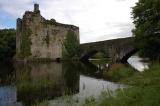
Carrigadrohid
Encyclopedia
Carrigadrohid: is a village in the Canovee
Electoral Area of Mid-Cork, Ireland, situated on the north bank of the River Lee (Laoi). It is the commercial and sporting capital of the Canovee area, with educational and ecclesiastical facilities being located in the nearby village nucleus of Canovee (Ceann an Mhaighe- The head of the plain) to the south.
In 2007, the Canovee Junior A team won the All-Ireland Junior Football Championship, defeating The Rock of Tyrone in Pairc an Chrocaigh.
Local hurlers play for Canovee's sister-club Cloughduv. Local female athletes play Gaelic football for Saint Val's and camogie for Cloughduv.
Canovee GAA has a large playing field and two smaller training pitches on the club's main campus- with a recently redeveloped playing field at Lehane's inch, on the banks of the Lee, near the hydroelectric power station.
It was besieged by Parliamentary forces following the Battle of Macroom, and Bishop MacEgan of Ross was hanged by the reins of his own horse outside the castle having refused to implore the Irish garrison to surrender to the Cromwellian army.
The MacCarthys were dispossessed and the castle ended up in the hands of the Bowen family. It has been in ruins since the late 18th century.
In recent years, a local group has been formed with the aim of preserving the castle.
Canovee
Canovee is a rural area and village nucleus in the Lee valley, Co. Cork, Ireland. It is centred on the former Roman Catholic and Church of Ireland parishes of Cannaway, in the barony of East Muskerry.- The Island of Cannaway :...
Electoral Area of Mid-Cork, Ireland, situated on the north bank of the River Lee (Laoi). It is the commercial and sporting capital of the Canovee area, with educational and ecclesiastical facilities being located in the nearby village nucleus of Canovee (Ceann an Mhaighe- The head of the plain) to the south.
Canovee GAA
Carrigadrohid is the home of Canovee GAA Club (Cumann Luthchleas Gael Cheann an Mhaighe), an intermediate Gaelic football club with a catchment area centred around Carrigadrohid and extending south and east to Aherla, Farnanes and Cloughduv.In 2007, the Canovee Junior A team won the All-Ireland Junior Football Championship, defeating The Rock of Tyrone in Pairc an Chrocaigh.
Local hurlers play for Canovee's sister-club Cloughduv. Local female athletes play Gaelic football for Saint Val's and camogie for Cloughduv.
Canovee GAA has a large playing field and two smaller training pitches on the club's main campus- with a recently redeveloped playing field at Lehane's inch, on the banks of the Lee, near the hydroelectric power station.
Amenities
- Canovee GAA grounds. Home to Canovee GAA Club (Cumann Luthchleas Gael Cheann an Mhaighe).
- Carrigadrohid Tennis Club.
- Angling spots at "Castle Bridge" and the Cam rua.
- Riverside walkways.
- Carrigadrohid Waterski & Wakeboard Club.
- Carrigadrohid castle.
- Carrigadrohid dam & Reservoir.
- The Carraig Inn.
- Dunnes' Foodstore.
- Leeside Nurseries.
- Bus Éireann stop on the Cork- Macroom northern (R618) route.
Castle
Carrigadrohid castle stands on a rock in the middle of the river Lee adjacent to the bridge which gives the village its name. It was erected in the 15th century by the MacCarthys of Muskerry, with an extension to the east and an annex to the north being added in subsequent centuries.It was besieged by Parliamentary forces following the Battle of Macroom, and Bishop MacEgan of Ross was hanged by the reins of his own horse outside the castle having refused to implore the Irish garrison to surrender to the Cromwellian army.
The MacCarthys were dispossessed and the castle ended up in the hands of the Bowen family. It has been in ruins since the late 18th century.
In recent years, a local group has been formed with the aim of preserving the castle.
See also
- List of towns and villages in Ireland

